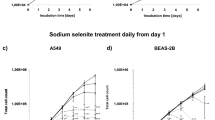Abstract
We previously demonstrated that treatment of HeLa cells with buthionine sulfoximine (BSO), which decreases the level of cellular glutathione, resulted in a decrease in the potency of selenite in inhibiting cell colony formation. We have now examined the effect of selenite on normal human lung fibroblast (CCL-210) cells, which resemble HeLa cells in their sensitivity to BSO, and on human lung adenocarcinoma (A549) cells, which are relatively insensitive to BSO. We have found that BSO treatment caused an approximately fourfold decrease in selenite potency in the CCL-210 cells, but had no significant effect on its potency in A549 cells. These results support the hypothesis that for selenite to exert its cytotoxic effect, it must under-go the reaction with an SH compound to form the selenotrisulfide. As a result of the lower sensitivity of the tumor cells to BSO, it was possible to achieve a large differential sensitivity to the cytotoxic effect of selenite.
Similar content being viewed by others
References
D. Medina and D. Morrison,Pathol. Immunopathol. Res. 7, 187–199 (1988).
L. Vernie,Biochim. Biophys. Acta 783, 203–217 (1984).
L. Clark, K. Cantor, and W. Allaway,Arch Environ. Health 46, 37–42 (1991).
R. LeBoeuf, B. Laishes, and W. Hoekstra,Cancer Res. 45, 5496–5504 (1985).
D. Medina and C. Oborn,Cancer Lett. 13, 333, 334 (1981).
J. Milner and C. Hsu,Cancer Res. 41, 1652–1656 (1981).
H. Ganther,J. Am. Coll. Toxicol. 5, 1–5 (1986).
W. Rhead and G. Schrauzer,Bioinorganic Chem. 3, 225–242 (1974).
G. Schrauzer, in J. Neve and A. Favier, eds.,Selenium in Medicine and Biology, De Gruyter, Berlin, 1989, pp. 251–261.
H. Ganther,Biochemistry,7, 2898–2905 (1968).
L. Vernie, M. DeVries, L. Karreman, R. Topp, and W. Bont,Biochim. Biophys. Acta 739, 1–7 (1983).
L. Vernie, J. Collard, A. Eker, A. DeWidt, and I. Wilders,Biochem. J. 180, 213–218 (1979).
G. Frenkel, and D. Falvey,Mol. Pharmacol. 34, 573–577 (1988).
G. Frenkel and D. Falvey,Biochem. Pharmacol. 38, 2849–2852 (1989).
G. Frenkel, A. Walcott, and C. Middleton,Mol. Pharmacol. 31, 112–116 (1987).
G. Batist, A. Katki, G. Klecker, and C. Myers,Cancer Res. 46, 5482–5485 (1986).
K. Poirier and J. Milner,J. Nutr. 113, 2147–2154 (1983).
L. Vernie, C. Homberg, and W. Bont,Cancer Lett. 14, 303–308 (1981).
P. Caffrey and G. Frenkel,Mol. Pharmacol. 39, 281–284 (1991).
A. Russo, W. DeGraff, N. Friedman, and J. MitchellCancer Res. 46, 2485–2848 (1986).
C. Ip and H. Ganther,Cancer Res. 50, 1206–1211 (1990).
D. Morrison, R. Berdan, D. Pauly, D. Turner, C. Oborn, and D. Medina,Anticancer Res. 8, 51–64 (1988).
J. Biaglow, M. Varnes, E. Clark, and E. Epp, inBiochemical Modulation of Anticancer Agents: Experimental and Clinical Approaches, F. Valeriote and L. Baker, eds., Martinus Nijhoff, Boston, MA, 1986, pp. 205–244.
C. Wolf, A. Lewis, J. Carmichael, D. Adams, S. Allan, and D. Ansel,Biochem. Soc. Trans. 15, 728–730 (1987).
L. Hosking, R. Whelan, S. Shellard, P. Bedford, and B. Hill.Biochem. Pharmacol. 40, 1833–1842 (1990).
S. Barranco, K. Weintraub, E. Beasley, V. Jenkins, and C. Townsend,Investigational New Drugs 9, 29–36 (1991).
O. Griffith and A. Meister,J. Biol. Chem. 257, 13,704–13,712 (1982).
J. Ford, J. Yang, and W. Hait,Cancer Res. 51, 67–72 (1991).
R. Ozols, K. Louie, J. Plowman, B. Behrens, R. Fine, D. Dykes, and T. Hamilton,Biochem. Pharmacol. 36, 147–153 (1987).
R. Ozols, T. Hamilton, H. Masuda, and R. Young, inMechanisms of Drug Resistance in Neoplastic Cells, P. Wooley and K. Tew, eds., Academic, San Diego, CA, 1988, pp. 289–306.
Author information
Authors and Affiliations
Rights and permissions
About this article
Cite this article
Caffrey, P.B., Frenkel, G.D. Selenite-induced inhibition of colony formation by buthionine sulfoximine-sensitive and resistant cell lines. Biol Trace Elem Res 35, 129–136 (1992). https://doi.org/10.1007/BF02783725
Received:
Accepted:
Issue Date:
DOI: https://doi.org/10.1007/BF02783725




